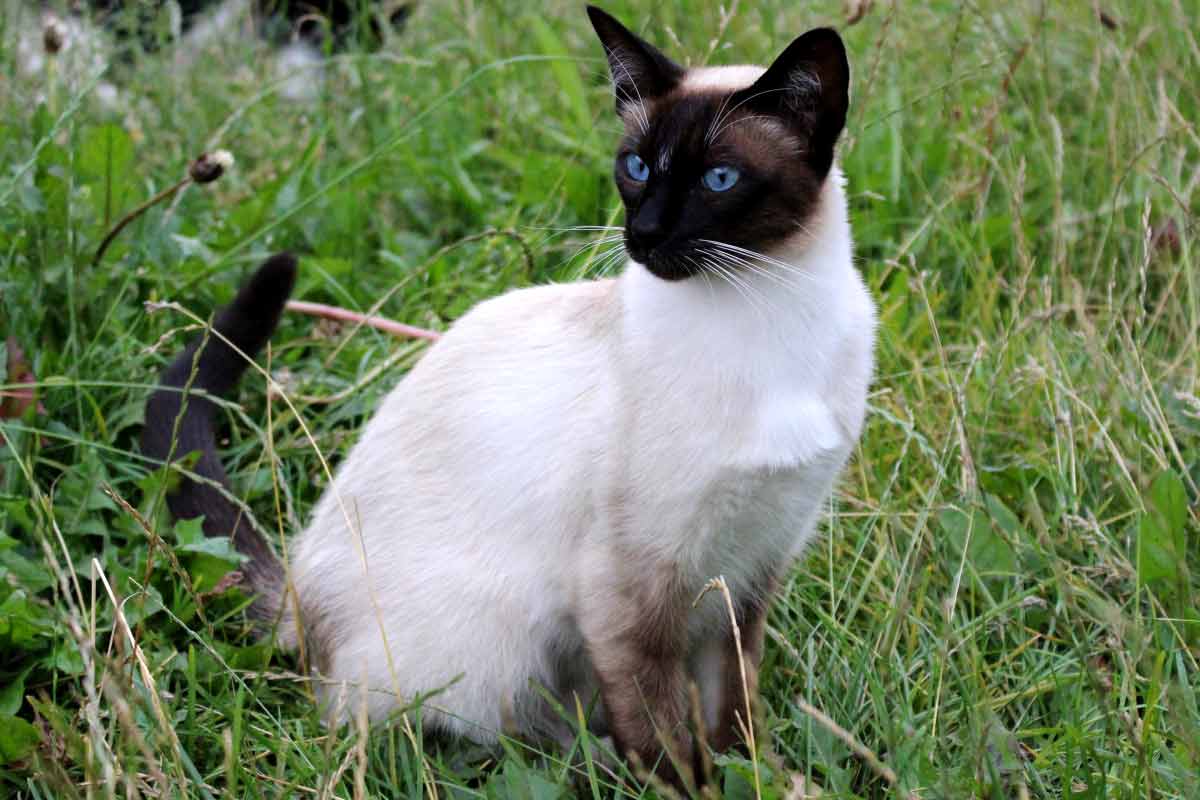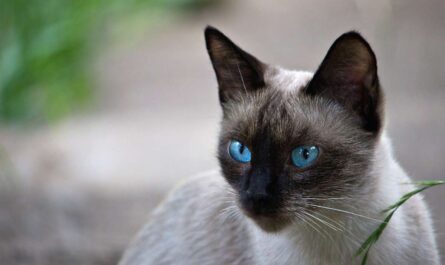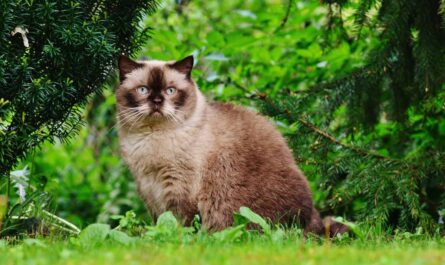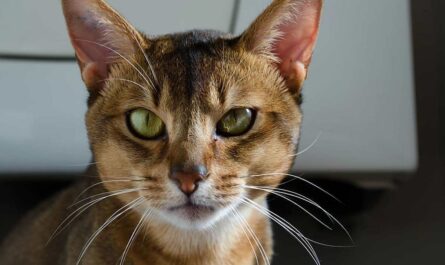Do not let the name deceive you; the Balinese cat breed draws its name from the graceful traditional Balinese dancers, yet their origins do not trace back to Indonesia. In a fascinating twist of fate, the long-haired splendor of the Balinese emerged from a mutation within a Siamese cat litter during the 1940s in the United States. Today, these captivating felines are celebrated for their entrancing sapphire blue eyes and their inherently sociable dispositions.
Set aside any preconceived notions – Balinese cats, inspired by the grace of traditional Balinese dancers, don’t trace their origins to Indonesia. Instead, they owe their existence to a captivating genetic peculiarity that bestows upon them their luxurious, flowing coats.
These captivating creatures are profoundly sociable and spirited, thriving when they bask in the spotlight. They possess an innate talent for vocalizing their desires, ensuring that their wishes never go unnoticed, and expressing their intentions with unmistakable clarity.
Radiating an aura of grace, regality, and sociability, Balinese cats may occasionally be confused with Siamese cats, but they indeed comprise a unique breed. What truly distinguishes them is their opulent, cascading fur, often creating a visual illusion of grandeur.
If the notion of welcoming a Balinese cat into your family has crossed your mind, allow us to craft a vivid portrayal of their personalities and what it entails to share your life with these captivating creatures. You may soon discover that these felines are the perfect addition to your household.
Origins of the Balinese Cat
One could be forgiven for assuming that the Balinese cat has its roots firmly planted in Bali, given its name. However, such an assumption couldn’t be further from the truth. The moniker ‘Balinese’ merely pays homage to the grace and elegance exhibited by the Balinese dancers within Bali’s temples.
Ironically, the Balinese cat boasts no Indonesian heritage. Its lineage extends back to 1940s America. (In stark contrast, its Siamese cousins originated in Thailand.)
In a peculiar twist of fate, a Siamese cat birthed a litter that included one kitten adorned with exceptionally long hair. The identity of the father remains cloaked in mystery, with some speculating a Persian cat as the potential mate.
Regardless of the kitten’s lineage, Siamese breeders Helen Smith, Sylvia Holland, and Marion Dorsey were immediately entranced by the long-haired Siamese and embarked on a novel breeding endeavor. Balinese breeders, in turn, committed themselves to safeguarding the natural mutation responsible for the extended hair.
Though some may view the Balinese as a mere variation of the Siamese, the Cat Fanciers’ Association (CFA) bestowed official championship status upon the breed in 1961. The Cat Fanciers Federation and the International Cat Association swiftly followed suit, solidifying the Balinese cat’s status as a beloved and recognized breed.
Since then, the Balinese cat has endeared itself as an affectionate and cherished addition to countless families, offering years of companionship and opportunities for growth.
History of the Balinese Cat
The traditional Balinese cat shares a historical backdrop with the Siamese breed, with both cats making appearances in photographs during the mid to late 1800s. Early Balinese cats were often spotted alongside Siamese cats, leading to speculations that they might have been Siamese mutations sporting long fur. See why thousands of cats love BoxCat
Alternative theories suggest their origin in western China or the result of British breeders crossing Angora and Turkish Angora cats. Nonetheless, the long-haired variety persisted, and in 1928, a long-haired Siamese was registered by the Cat Fanciers’ Federation.
The Balinese cat’s ascent to prominence began in 1955, thanks to the efforts of Marion Dorsey from California. By selectively breeding Balinese with Balinese cats, a pure breed emerged, though it was still initially referred to as the Long-Haired Siamese. The name ‘Balinese’ was later bestowed upon the breed due to its striking resemblance to the graceful and athletic Balinese dancers.
Official recognition and registration for the Balinese cat took place in 1961, but initially, it was only for traditional Siamese point colors, excluding the broader range of hues. Other colors were registered under names like Javanese or Oriental Shorthairs.
The modern Balinese cat, while retaining its elegance, is now smaller and more robust than the breed showcased in the 1950s. True Balinese cats are considered rare, and prospective owners are advised to delve into the cat’s lineage before making a purchase.
Personality and Temperament of the Balinese Cat
The Balinese cat is renowned for its friendly and easygoing nature. In stark contrast to their Siamese relatives, Balinese cats are notably less high-strung and certainly less vocal. These felines revel in human company and detest prolonged periods of solitude. You’ll often find them gracefully trailing you from room to room, savoring your presence. Cat accessories on Amazon
The personality of a typical Balinese cat shares remarkable similarities with Siamese cats, offering a tapestry of traits that include curiosity, playfulness, vocal expressiveness, and a penchant for acrobatics. These felines embody boundless energy, coupled with an ardent affection for their human families. Historical accolades for their adept hunting prowess and adaptability further underscore their exceptional nature.
Balinese cats seamlessly integrate into various households, including those with children. Their intelligence shines through as they eagerly engage in interactive play and games, making them wonderful companions. The disposition of a Balinese cat closely mirrors that of its Siamese kin. These felines are extroverted, and spirited, and flourish in the company of their human companions. To ensure their contentment, devote ample time and attention to their needs.
A Balinese cat is not suited for individuals seeking a hands-off feline companion. Active engagement with your Balinese is essential for their well-being.
Distinguishing Balinese Cats from Siamese Companions
Among the many remarkable traits of Balinese cats, their eyes stand out as a signature feature, captivating all who behold them with their resplendent and steadfast blue hue. What truly sets them apart, however, is their exquisite coat, a distinct departure from their Siamese relatives.
Monica Frenden-Tarant, Chief Innovation Officer of Feline Lifesaving at the Cincinnati Animal CARE Humane Society, elaborates on this distinction, remarking, “The Balinese boasts a medium-length, cream-colored coat that is exceptionally soft and silky, devoid of the undercoat commonly found in other breeds. Notably fluffier tails adorned with discernible plumes further accentuate their color points.”
In addition to their lengthier fur, modern Balinese cats boast a more triangular head shape, an elongated and slender muzzle, broader ears, and a sleeker physique compared to their Siamese counterparts. Robust, muscular bodies are upheld by their sizeable paws, while a dense two-layered coat serves to insulate them against the elements, ensuring warmth and dryness.
Exploring Common Balinese Cat Diseases & Conditions
While generally robust and healthy, Balinese cats share certain health concerns with their Siamese counterparts. “Progressive retinal atrophy emerges as the most prevalent of these conditions, alongside liver amyloidosis, asthma or bronchial diseases, and cardiomyopathy,” notes Frenden-Tarant.
Lysosomal Storage Disease: This genetic ailment in cats stems from a deficiency of enzymes required for vital metabolic functions. Although not a widespread disease, it typically manifests in young kittens. Affected cats accumulate substances in their bodies that would typically be eliminated by enzymes, sadly resulting in a fatal outcome.
Furballs: Contrary to their name, furballs are not ball-shaped; instead, they resemble cigar-shaped clumps that a cat may occasionally vomit. These are a result of cats digesting fur that accumulates in the stomach due to grooming. These masses can lodge themselves in the upper intestine or stomach, potentially leading to blockages. Furballs can arise when a cat sheds more hair than usual, often due to factors such as stress, skin irritation, or obesity. Maintaining a healthy diet can help minimize episodes of furballs.
To safeguard the well-being of these feline companions throughout their lifespan, which typically spans 8 to 13 years, diligent pet parents should adhere to a regimen of regular veterinary checkups and vaccinations.
The People-Oriented Prowess of Balinese Cats
Your Balinese cat shall become your devoted shadow, dutifully trailing your every step. They revel in engaging conversations, actively seeking the spotlight as they strive to be the focal point of your world.
Balinese cats wholeheartedly endeavor to please their human counterparts, considering your companionship an invaluable treasure. With a Balinese by your side, solitude becomes a relic of the past.
The Playful and Expressive Nature of Balinese Cats
If you anticipate tranquility and silence, the presence of a Balinese cat may deliver quite the opposite. Balinese cats, akin to their Siamese brethren, possess an inherently talkative disposition. They delight in conversing with you, discussing you, addressing you, or simply sharing their musings throughout the day. Prepare for numerous delightful dialogues with your Balinese companion.
In addition to their vocal proclivities, Balinese cats thrive on interactive play with their human companions. They prefer engaging their humans in playful activities and inventing new, enjoyable games to unravel. Enrich their lives with playscapes, interactive toys, cat furniture, and food puzzles to keep your Balinese entertained while you toil.
The Affable and Hospitable Nature of Balinese Cats
Despite their regal facade, Balinese cats radiate warmth and affection, extending their welcoming embrace to diverse individuals. They adapt seamlessly to new acquaintances, wasting no time in forging connections. Their genial disposition renders them outstanding family pets, displaying tolerance towards well-behaved children while forming robust bonds, provided they are treated with respect.
The Curiosity and Intelligence Inherent in Balinese Cats
Balinese cats harbor keen intelligence and an insatiable curiosity that propels them into active engagement with their surroundings. They relish participating in various activities and perpetually seek opportunities to immerse themselves in the action.
Their innate curiosity, when paired with bouts of boredom, may lead to mischief. In the absence of adequate entertainment, Balinese cats are known for crafting their own means of dispelling monotony, often culminating in endearing antics.

Fascinating Balinese Cat Facts
- The name ‘Balinese’ doesn’t derive from Bali, as some might assume. Instead, it’s an ode to their graceful and athletic physique, reminiscent of the captivating Balinese dancers.
- Despite being less vocal than Siamese cats, Balinese cats have a penchant for engaging in conversations with their owners.
- Balinese cats can be trained to walk on leashes, making them amenable to occasional outdoor strolls.
- These felines usually relish the company of strangers, often opting to curiously investigate newcomers rather than hiding away in a room. See why thousands of cats love BoxCat
The Allergy Question: Are Balinese Cats Hypoallergenic?
While the concept of a truly hypoallergenic cat remains elusive, Balinese cats, when juxtaposed with other breeds, exhibit a reduced production of protein antigens known to trigger allergies in some individuals. Their minimal shedding tendencies may provide some relief for allergy sufferers.
To maintain their longer coat, Balinese cat parents should engage in regular grooming, recognizing that felines are adept at self-cleaning. However, to prevent matting in the more challenging-to-reach areas, a trimming regimen or professional grooming service may be advisable. Cat accessories on Amazon
Energetic, Active, and Adventurous Souls
Balinese cats exude boundless energy and enthusiasm, representing a robust breed with an insatiable thirst for adventure. They demand both attention and playtime to thrive, with scratching posts, cat trees, and perches serving as essential outlets for their exuberant spirits.
Balinese cats are renowned for harmonizing well with dogs and fellow cats, especially when serving as companions who assist in expanding their reservoirs of energy throughout the day.
A Visual Odyssey into the World of Balinese Cats
Distinguished by their silky colorpoint coats and captivating blue eyes, Balinese cats effortlessly captivate the beholder’s gaze. They boast a graceful and svelte physique, defined by delicate bones and a well-sculpted musculature. These medium-sized marvels sport lengthy, plume-like tails and gracefully proportioned limbs.
Balinese cats showcase long or semi-long hair, characterized by its fineness and absence of an undercoat. This unique coat structure often classifies them as a hypoallergenic breed, owing to their reduced production of Fel d 1, the protein responsible for human cat allergies.
To maintain their resplendent coats, Balinese cat caretakers partake in weekly grooming sessions, cherished as bonding moments. Their coat colors align closely with the Siamese cat, showcasing various point patterns and hues, including lilac point, chocolate point, seal point, and blue point. The kaleidoscope of eye colors ranges from pale blue and deep azure to lilac and beyond. (Fun fact: Some Balinese cats exhibit crossed eyes.)
In the presence of a Balinese cat, one cannot help but be entranced by its majestic elegance, evoking an indescribable sense of enchantment. Building trust and affection with a Balinese is an exhilarating experience.
Caring for a Balinese Cat
Before embarking on the journey of adopting a Balinese cat, it is essential to evaluate the level of attention and care you can provide. If your lifestyle involves frequent travel, long work hours, or only permits one pet, owning a Balinese may pose certain challenges.
As a responsible owner, maintaining a pristine and elegant bathroom space is crucial. A self-cleaning litter box not only offers an always-clean environment but also adds a touch of royalty to their daily routine. Balinese cats rely on your consistent presence and attention. Neglecting their need for companionship can lead to destructive behavior and feelings of depression.
When the time is right, bringing home a Balinese cat heralds a significant moment in your life. In return for your care, you’ll receive boundless love, unwavering companionship, the delight of an affectionate and outgoing personality, and a lifetime filled with the endearing antics of your Balinese companion.
More Interesting Articles
- 13 Very Interesting Facts About an Orange Tabby Cat
- Maine Coon Cat Breed: Traits, Profile, Personality, Facts
- 13 Interesting Fun Facts about Siamese Cats & Kittens
- 7 Amazing Light Brown (Beige) Cream Cat Breeds
- 10 Amazing Blue Cat Breeds with Short or Long Hair
- 11 Interesting Facts about a Cream Cute Tabby Cat
- 13 Common Symptoms of A Dead Kitten Inside A Cat
- Neutering Male Cats: Behavior and Recovery Guide
- How to Help a Choking Cat: Signs, Precautions, Tips
- Cat Dry Heaving: Cat Gagging Causes and What to Do
- Why is My Cat Panting? Symptoms, and Treatment
- 26 Tips How to Train A Cat Not to Scratch You or Anything
- Everything You Need to Know about Owning A Cat: 23 Facts
- How to Easily Train Your Cat to Use Toilet in One Week
- 10 Steps How to Train A Kitten to Use A Litter Box in a Week
- 10 Tips How to Train A Cat to Walk On a Leash in A Week
- 6 Steps How to Train A Cat Not to Bite Your Hand or Skin
- 6 Steps How to Get My Cat to Stop Jumping on the Counter
- 8 Tips on Introducing A New Dog To A Cat Step By Step
- 27 Tips How to Train An Outdoor Cat to Stay Home



